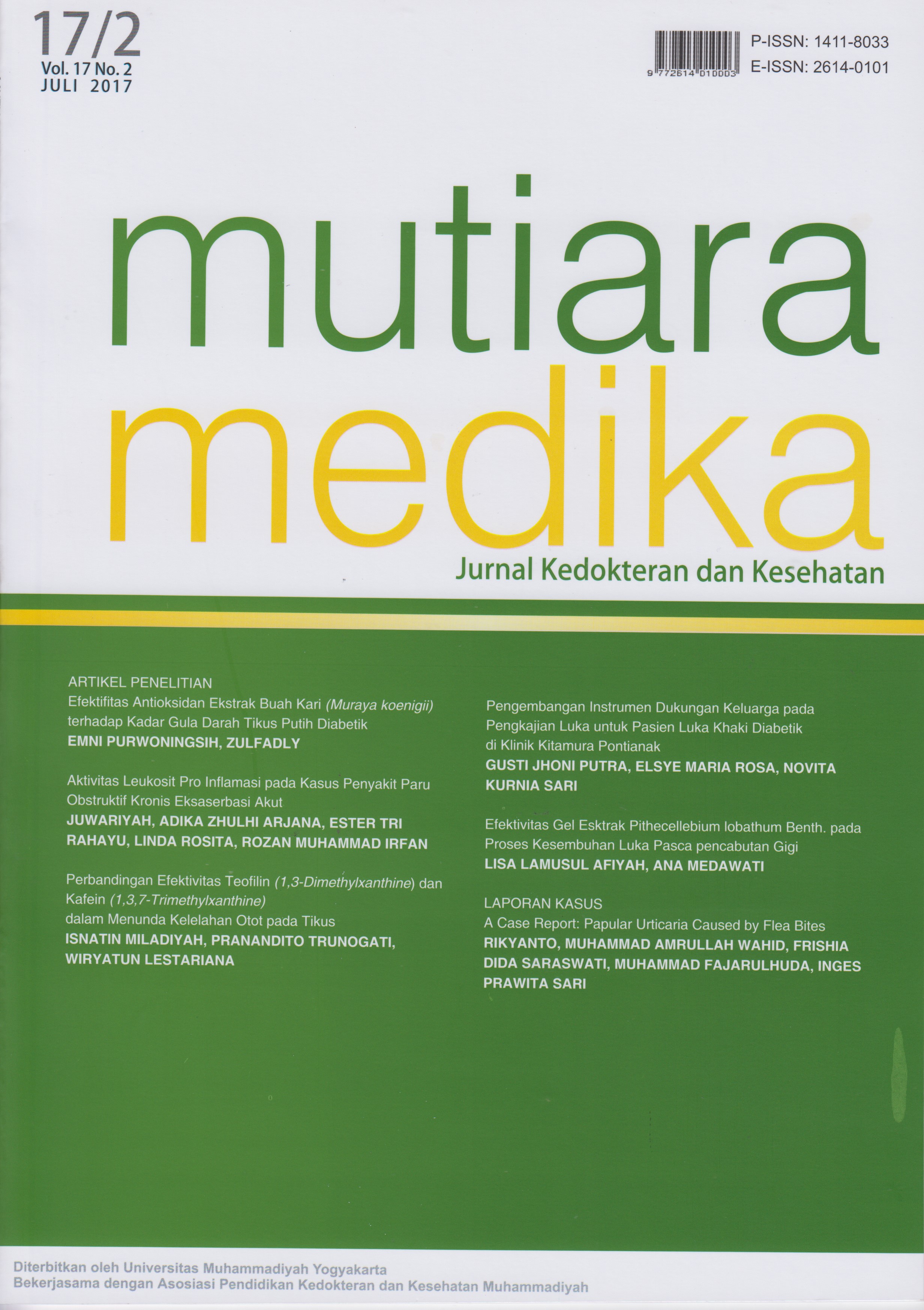Pengembangan Instrumen Dukungan Keluarga pada Pengkajian Luka untuk Pasien Luka Kaki Diabetik di Klinik Kitamura Pontianak
DOI:
https://doi.org/10.18196/mm.170204Keywords:
Pengkajian, Luka Kaki Diabetik, Dukungan KeluargaAbstract
Peningkatan kualitas hidup pasien Luka Kaki Diabetik (LKD) merupakan tujuan dari asuhan keperawatan. Dukungan keluarga merupakan salah satu aspek penting yang perlu diperhatikan pada pasien LKD, hal ini dikarenakan aktifitas dukungan keluarga sangat berpengaruh pada fisiologis tubuh dan kualitas hidup. Belum tersedianya instrumen pengkajian keluarga merupakan perhatian khusus untuk menentukan diagnosis dan intervensi yang sesuai. Tujuan penelitian ini adalah untuk mengembangkan pengkajian dukungan keluarga pada pasien LKD. Jenis penelitian ini adalah mixed method dengan desain sequential exploratory. Tahap kualitatif melibatkan 4 partisipan dan tahap kuantitatif melibatkan 73 responden, dengan kriteria inklusi pasien rawat jalan atau rawat inap dan mengalami LKD pada fase proliferasi, sedangkan kriteria ekslusi pasien LKD fase proliferasi membaik dan berhenti melakukan perawatan sebelum minimal waktu penelitian. Uji validitas dengan pendekatan test-retest menggunakan pearson product moment, uji reliabilitas dengan cronbach’s alpha dan Aiken’s V digunakan untuk uji pakar pada 2 orang ahli. Hasil kualitatif didapatkan 4 tema untuk dukungan keluarga. 14 item alat ukur didapatkan hasil yang valid (0,372-0,843 > 0,235) dan reliabel (Cronbach alpha 0,959 dan 0,976). Hasil indeks validitas konten 0,67-0,83. Disimpulkan bahwa terdapat 4 tema aspek dukungan keluarga dan pengembangan instrumen dukungan keluarga pada pengkajian luka yang terdiri dari 13 item, dinyatakan valid dan reliabel.References
Suriadi. Manajemen Luka. Pontianak: Sekolah Tinggi Ilmu Keperawatan Muhammadiyah Pontianak. 2010.
Firman A. Kualitas Hidup Pasien Ulkus Diabetik di Rumah Sakit Umum Daerah Serang. Tesis. Jakarta: Universitas Indonesia. 2012.
Grant W, Schmittdiel JA. Adults with Diabetes who Perceived Family Members Behaviour as Unsupportive are Less Adherent to Their Medication Regimen. Evid Based Nurs, 2013; 16 (1): 15-16.
Gouin J. The Impact of Psychological Stress on Wound Heaking: Methods and Mechanisms. NIH Public Access, 2012; 31 (1): 81-93.
Uchino BN. Social Support and Health: A Review of Physiological Processes Potentially Underlying Links to Disesase Outcomes. J Behav Med, 2006; 29 (4): 377-387.
Creswell JW. Research Design Pendekatan Kualitatif, Kuantitatif dan Mixed edisi Ketiga. Yogyakarta: Pustaka Pelajar. 2016.
Alligood M. Nursing Theorist and Their Work. Eight edition. USA: Elsevier. 2006.
Bomar PJ. Promoting Health in Families: Applying Family Research and Theory to Nursing Practice. 3rd Edition. New York: Saunders. 2014.
Coffman J. Family Support and Health: A Review of Physiological Processes to Disesase Outcomes. J Behav Med, 2008; 4 (1): 257-267.
Chen. Health Behavior and Health Education: Theory, Research and Practice. Fourth Edition. United States America: John Wiley and Sons. 2012.
Sarafino EP. Health Psychology: Biopsychosocial Interaction. 8th Edition. New York: John Wilky Inc. 2015.
Macrodimitris SD, Endler NS. Coping, Control and Adjustment in Type 2 Diabetes. Health Psychol, 2001; 20 (3): 208-216.
Teare J, Barrett C. Using Quality of Life Assessment in Wound Care. Nurs Stand, 2002; 17 (6): 59-68.
Tao H. Impact of Social Environmental Factors on Re-Hospitalization of Home Healthcare Elderly Patients. Proquest, Nursing Health Policy Program. 2011.
Sunaryo. Psikologi untuk Keperawatan. Jakarta: EGC. 2014.
Tracey P. Psychological Aspects of Wound Care: Implications for Clinical Practice. JCN, 2010; 16 (1): 23-38.
Effendi F. Keperawatan Kesehatan Komunitas: Teori dan Praktek dalam Keperawatan. Jakarta: Salemba Medika. 2013.
Upton D. Psychological Aspects of Wound Care: Implications for Clinical Practice. JCN, 2014; 28 (2): 52-57.
Robson MC, Barbul A. Guidelines for the Best Care of Chronic Wounds. Wound Repair Regen, 2006; 14 (6): 647-648.
Schaper NC, Andros G, Apelqvist J, Bakker K, Lammer J, Lepantalo M, et al. Specific Guidelines for the Diagnosis and Treatment of Peripheral Arterial Disease in a Patient with Diabetes and Ulceration of the Foot 2011. Diabetes Metab Res Rev, 2012; 28 (Suppl 1): 236-237.
Downloads
Published
Issue
Section
License
Copyright
Authors retain copyright and grant Mutiara Medika: Jurnal Kedokteran dan Kesehatan (MMJKK) the right of first publication with the work simultaneously licensed under an Attribution 4.0 International (CC BY 4.0) that allows others to remix, adapt and build upon the work with an acknowledgment of the work's authorship and of the initial publication in Mutiara Medika: Jurnal Kedokteran dan Kesehatan (MMJKK).
Authors are permitted to copy and redistribute the journal's published version of the work (e.g., post it to an institutional repository or publish it in a book), with an acknowledgment of its initial publication in Mutiara Medika: Jurnal Kedokteran dan Kesehatan (MMJKK).
License
Articles published in the Mutiara Medika: Jurnal Kedokteran dan Kesehatan (MMJKK) are licensed under an Attribution 4.0 International (CC BY 4.0) license. You are free to:
- Share — copy and redistribute the material in any medium or format.
- Adapt — remix, transform, and build upon the material for any purpose, even commercially.
This license is acceptable for Free Cultural Works. The licensor cannot revoke these freedoms as long as you follow the license terms. Under the following terms:
Attribution — You must give appropriate credit, provide a link to the license, and indicate if changes were made. You may do so in any reasonable manner, but not in any way that suggests the licensor endorses you or your use.
- No additional restrictions — You may not apply legal terms or technological measures that legally restrict others from doing anything the license permits.



